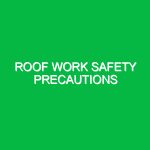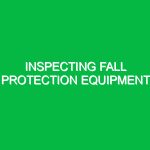In the world of Health, Safety, and Environment (HSE), ensuring the safety of employees is paramount, particularly in industries where falls are a significant risk. Fall protection plans and training are essential components of workplace safety strategies aimed at preventing falls from heights, which can lead to severe injuries or fatalities. This article delves into the intricacies of fall protection plans and training, exploring their relevance, potential hazards, safety precautions, and the regulations governing them.
Defining Fall Protection Plans and Training
A fall protection plan is a comprehensive strategy designed to identify and mitigate fall hazards in the workplace. It outlines the necessary measures and protocols to protect workers who are at risk of falling from elevations, such as scaffolding, roofs, or ladders. On the other hand, fall protection training equips employees with the knowledge and skills required to recognize fall risks and utilize protective equipment effectively. Together, these elements form a robust defense against fall-related incidents.
The relevance of fall protection plans and training cannot be overstated. According to the Occupational Safety and Health Administration (OSHA), falls account for a significant percentage of workplace injuries and fatalities, especially in construction and maintenance sectors. Implementing effective fall protection measures not only safeguards employees but also enhances organizational productivity and morale.
Identifying Hazards and Risks in Fall Protection
Understanding potential hazards is the first step toward developing effective fall protection plans and training. Various risks exist in workplaces, and they can be broadly categorized into the following:
1. Unprotected Edges
Unprotected edges, such as rooftops and elevated platforms, pose a considerable risk. Workers may inadvertently step too close to the edge, leading to falls. A personal anecdote comes from a construction site where a worker, distracted by a colleague’s shout, stepped back and fell from a rooftop. Thankfully, he survived but suffered severe injuries. This incident underscores the importance of clearly marked boundaries and appropriate barriers.
2. Slippery Surfaces
Wet or oily surfaces can significantly increase the likelihood of slips, trips, and falls. For instance, during rainy weather, outdoor workspaces can become slick. Employers should ensure that surfaces are kept clean and dry and that appropriate signage is posted to warn employees of hazards.
3. Improper Use of Ladders and Scaffolding
Ladders and scaffolding are common tools in many industries, yet improper use remains a prevalent issue. A case study from a manufacturing plant revealed that inadequate training on ladder safety led to multiple accidents. Workers were not aware of the correct angles or weight limits, resulting in falls that could have been prevented with proper education.
4. Lack of Personal Protective Equipment (PPE)
Not using appropriate PPE, such as harnesses or guardrails, can expose workers to unnecessary risks. Employees need to be trained on the correct use and maintenance of fall protection gear to ensure their safety at all times.
Safety Precautions and Best Practices
To effectively mitigate the risks associated with falls, organizations must implement several safety precautions and best practices:
1. Conduct Regular Risk Assessments
Employers should perform routine inspections of the worksite to identify potential fall hazards. This proactive approach allows for the timely implementation of safety measures before incidents occur.
2. Establish Clear Protocols
Creating and communicating clear safety protocols is essential. Employees should understand the specific procedures to follow when working at heights, including the use of fall protection systems and emergency actions in case of a fall.
3. Provide Comprehensive Training
Training should encompass both theoretical knowledge and practical exercises. Workers should engage in simulations that prepare them for real-life scenarios. For example, a construction company in Texas implemented hands-on training sessions where employees practiced using harnesses and safety nets, significantly reducing incidents over time.
4. Ensure Proper Use of Equipment
Regularly inspect and maintain all fall protection equipment. This includes checking harnesses for wear and tear and ensuring ladders and scaffolding are stable. Employees should be trained on how to conduct these inspections themselves.
5. Foster a Safety Culture
Encouraging a culture of safety where employees feel comfortable reporting hazards or unsafe conditions is crucial. When team members feel responsible for one another’s safety, they are more likely to adhere to safety protocols.
Regulations and Standards Governing Fall Protection
Several regulations govern fall protection plans and training, primarily enforced by OSHA. Key standards include:
1. OSHA Standard 1926.501
This standard outlines the requirements for fall protection in the construction industry. It mandates that employers must provide fall protection at elevations of six feet in the construction industry and at eight feet for general industry.
2. ANSI/ASSP Z359
The American National Standards Institute (ANSI) and the American Society of Safety Professionals (ASSP) have established a series of standards that provide guidelines for fall protection systems, training, and rescue procedures.
3. State-Specific Regulations
Many states have their own regulations that may be more stringent than federal standards. Employers should familiarize themselves with local laws to ensure compliance.
Conclusion: The Path to Safer Workplaces
Fall protection plans and training are critical components of workplace safety in any industry where employees face fall hazards. By identifying potential risks, implementing comprehensive safety measures, and adhering to regulatory standards, organizations can significantly reduce the likelihood of fall-related incidents. A commitment to training and continuous improvement in safety practices fosters a culture of safety that protects employees and enhances overall productivity.
As we continue to navigate the complexities of workplace safety, let us remember that effective fall protection is not merely a checklist item but a vital investment in the well-being of our workforce. The stories of those who have suffered from falls serve as a stark reminder of what is at stake and the importance of vigilance and preparedness in ensuring the safety of all employees.


